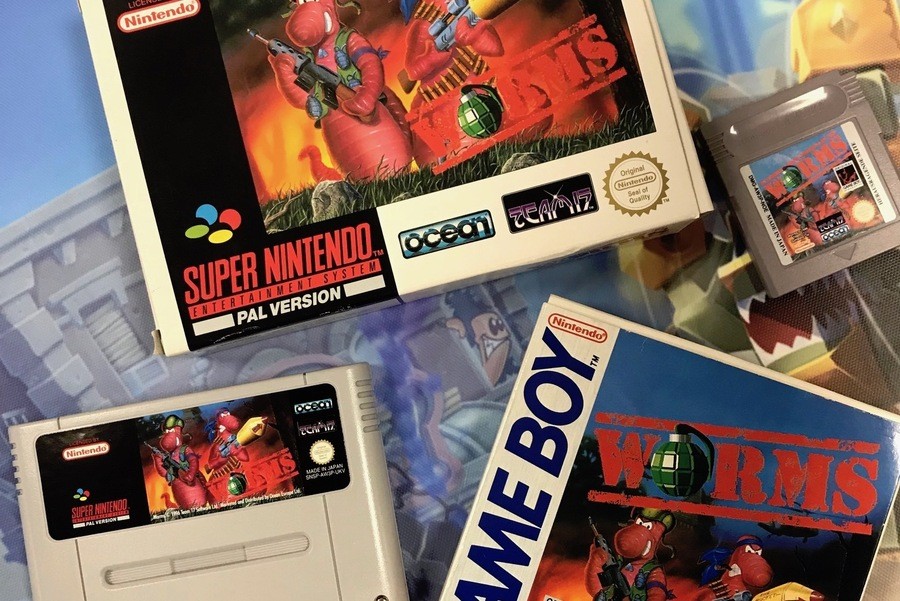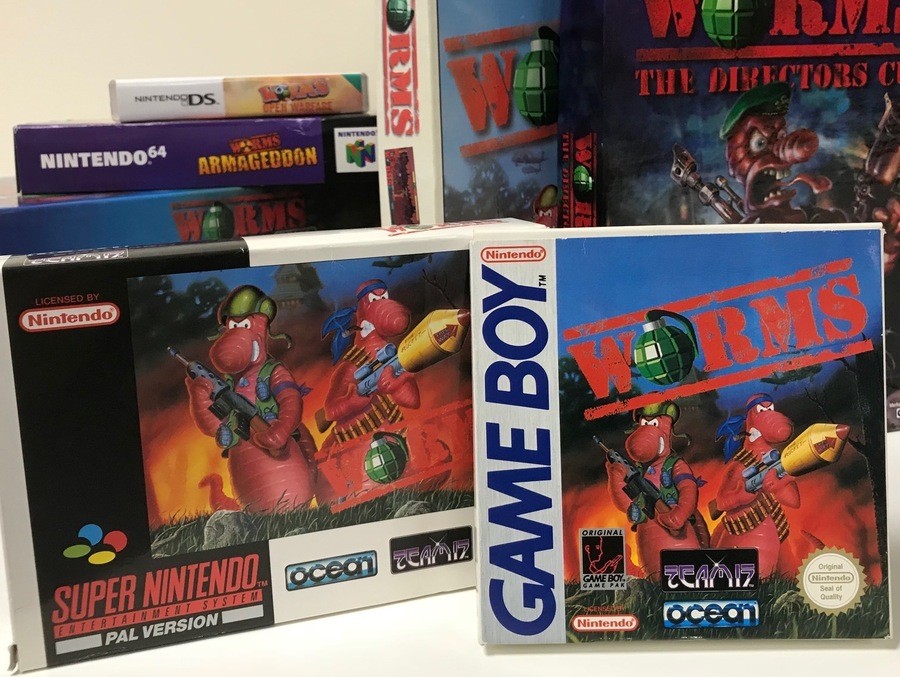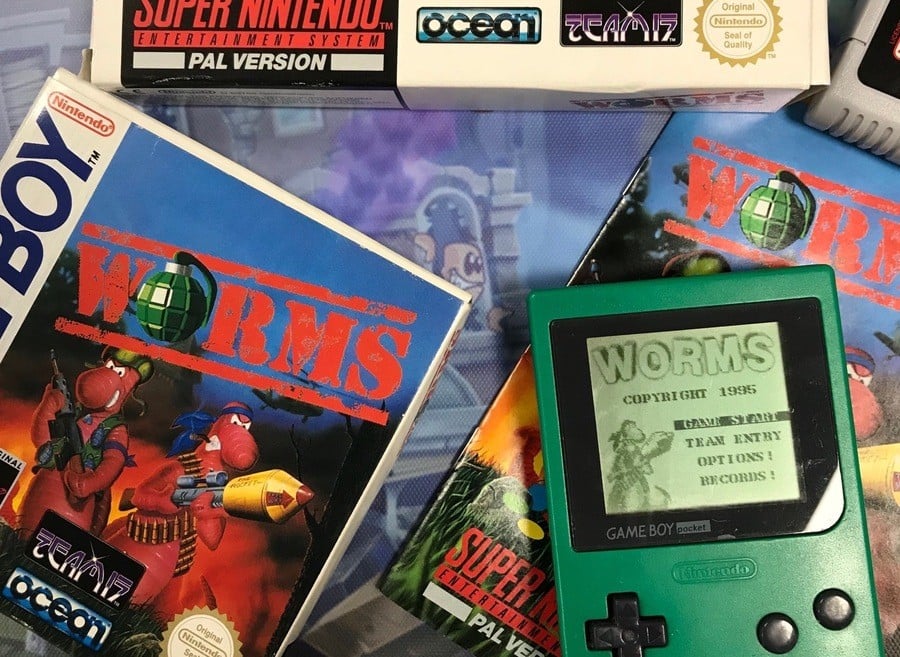
Recently, UK publisher Team17 passed a significant milestone - it released its 100th game. Since the company was founded in 1990, the firm has gone from being a developer to a fully-fledged publisher and has been behind classic titles such as Alien Breed, Superfrog, Body Blows and - of course - Worms. More recently, Team17 has published the likes of The Escapists 2, Overcooked, Yoku's Island Express and Planet Alpha - its aforementioned 100th release - on Switch.
We thought it might be an opportune time to take a look back at the company's first release on a Nintendo console, and there are no prizes for guessing what that game was. Released way back in 1996, the SNES and Game Boy ports of the original Worms were created by a small UK studio called East Point Software, and were developed by staffers Francis Lillie and Gavin Harwood. We caught up with the pair to chat about porting the legendary title to Nintendo's hardware, and what it feels like to have been involved with Team17's first steps into the. world of The Big N.
Nintendo Life: How did you become involved with Team17 and the Worms project?
Francis Lillie: I’d just been made unemployed and was looking around. A friend of mine whilst clubbing met the daughter of Russell Ritchie, owner of East Point, and my name was mentioned to her and then to Russell, and I was told that Gav was now working there and had been for about two weeks. Gav and I had worked together at the company where we’d both been made redundant, The Dome. I was called in for an interview and got the job there and then. Straight away I was asked if I’d heard of Worms or Total Wormage, which I said I had, and was told I’d be starting on the Mega Drive version. Someone else in-house had already started it, but it was running late; I was asked to take over. I think the second week I was there I met Team17's Martyn Brown, who had come down to talk about the three versions we were doing.

Gavin Harwood: After being made redundant from The Dome, I managed to get a job developing business software for a local company. At the time I found business software very tedious and uneventful compared to games. After one month I left the job and contacted East Point Software and went up for an interview; fortunately, they were looking for programmers to help out with the Sega Mega Drive version of Worms for Team17. When Francis started work with East Point Software he replaced me on the Mega Drive version and I got handed the Nintendo Game Boy version. All of the versions were behind schedule when both myself and Francis started work on them.
Had you played the game prior to being commissioned to work on the Nintendo ports? What did you think of it?
FL: I was aware of Total Wormage, but I don’t think I’d ever played it to be perfectly honest. I came into it blind.
GH: I had no idea what the game was about. Fortunately, we had a nearly complete Commodore Amiga version to play and assess. Following the completion of the Nintendo versions, both myself and Francis played Worms a lot, and I mean a lot! For some reason we stopped playing; I think Francis got fed up with losing, but he would not admit to that! I know the truth; he throws grenades like a newborn baby.
Why would you say you were selected by Team17 to work on these ports?
FL: East Point was actually a well-renowned conversion house with many conversions undertaken on many platforms, so I think we were a good choice for Team17.
GH: At the time the Sony PlayStation and the Sega Saturn had just been released, so it made sense that Team17 would pioneer the new consoles and farm out the older console versions.
Worms was, of course, a home computer game before it made the jump to consoles. What was the biggest technical challenge when ported it to the SNES and Game Boy?
FL: The biggest problem for me on Mega Drive and SNES was the terrain deformation. As both platforms were character-map based, real-time deformation at a pixel level was a huge obstacle, but one which Gav had solved and part-coded on Mega Drive before I joined. I had to re-code for SNES. Gav had even more hassles with Game Boy, but came up with an even more elegant solution. The details of the Mega Drive and SNES would bore you, but Game Boy was smart.
GH: I have to agree with Francis that the terrain deformation with the biggest technical challenge. The Mega Drive and SNES versions worked like the original Amiga at pixel level, which was really nice. However, the Game Boy just did not have the ability, so we had to design and build a set of 8x8 pixel blocks that could be used to generate terrains and be swapped out to create damage that looked like the bitmapped terrains on the bigger consoles. Let's put it into perspective; some of the icon graphics on today’s smartphones use more memory than we had for the complete game on SNES and Game Boy!

What was it like working on Nintendo's systems back then, compared to other formats?
FL: Up until then, I’d only ever done Amiga, PC and a little bit of Mega Drive programming, so the SNES was my first foray in 6502/65816, and I’ve got to say I really enjoyed it. The hardware was really, really nice as well. I was surprised at how powerful it was, to be perfectly honest. I cannot remember having any issues getting to grips with it.
GH: I had worked on Commodore 64s, Amigas and PCs. The Nintendo consoles had fantastic hardware, and we didn't have any issues with it. I think back in the good old days we all programmed in machine code / assembly language, which people nowadays very rarely come into contact with; you had to have a good understanding of what was happening under the bonnet. Nintendo always seemed to cater for programmers; it felt like a programmer had told Nintendo how they wanted the hardware to work.
Was the SNES version ported across from the Amiga or PC code? How did the SNES architecture differ from the source and what challenges did this throw up?
FL: I wrote the Mega Drive version first, and then ported to SNES. There were a few things on the Amiga version, which I used as a basis for porting to Mega Drive, which we couldn’t do, like the Ninja Rope. Between us, we just couldn’t come up with a solution. At the time, the Amiga version was far from complete, and we basically converted by playing the game rather than looking at source code, and from reading the rules for each weapon, which were documented.
GH: As Francis said, we did not use the original source code - after all, it was in Blitz Basic on the Amiga, we only understood 1s and 0s. We approached the development like an original product and used the Amiga version as a visual design document.
How did you go about changing mouse and keyboard controls to joypad? Did you build on Team17’s work on the CD32 version or did you have to start from scratch?
FL: We went from scratch, and went through a few mechanisms until we found one we thought worked, then went with that. I think it worked pretty well, to be honest.
GH: Porting mouse and keyboard controls to a console is not easy, and it often doesn't work. Sometimes it is best to create a new interface for the console.
Were there any compromises you had to make to get the game to run or fit in a certain cartridge size?
FL: I know we were told cartridge size up front, so we had to work to that. I know I had to use a few tricks on SNES to get it to fit, but nothing too drastic. It was mainly music and SFX which suffered slightly.
GH: I think this is where myself and Francis came into our own. We were used to working within hardware and memory constraints. Many PC coders at the time just wasted so much memory because they had so much more in comparison to the consoles. Knowing the upper limit up front helps, but we always coded optimally; less is more.
Do you have any amusing anecdotes or stories from the development of Worms?
FL: From my side, nothing you’d want to publish online. Both Gav and I were relatively young programmers at the time, and we split our time between Norfolk and Ossett a lot. Quite often we’d do 100-hour work in the 120 available between Monday and Friday, travelling home in the early hours of Saturday and back up on Sunday night. Stories of cold pizza breakfasts, lunchtime drinking sessions, greasy spoon café breakfasts, sleeping on the grass/under a desk abound.
GH: I cannot remember anything that Francis has said, I was a stand-up citizen in my younger years! However, on one occasion my monitor did go zipping across the office in a moment of rage, I then spent the next few weeks with a red halo around everything where the red gun in the CRT had been nudged out of place. Francis could demolish a keyboard with one hit; it’s not easy trying to remember what keys go where on a keyboard, that’s assuming you can find them all!

Team17 has since grown into one of the UK's most respected and successful publishers, and Worms continues to sell millions of units around the world. How does it feel to have been involved with such a landmark release for the company - its first ever Nintendo release?
FL: Until I was contacted for this piece, I had absolutely no idea that the SNES version of Worms was Team17’s first Nintendo release. I feel quite proud knowing it was, and I’m pleased with the game itself, given the technical difficulties and the relatively short development time.
GH: It is a funny thing; I never really think about it, at the time it was just another game. However, when people ask what games I have worked on, I always start the list with Worms. At the end of the day, I think the SNES, Game Boy and Mega Drive versions were all great technical achievements and we were fortunate to have had the opportunity to work on them.
Do you still play games?
FL: Most certainly. As often as time allows. I’m a shameless Nintendo fan. Any new proper Zelda and proper Mario game that comes out, I will buy. Even if it means getting a new platform. I'm also a big Gran Turismo fan.
GH: Yes, but not as much as I would like. I am Nintendo all the way, my favourites being Zelda, Mario, and Mario Kart. I am still trying to play the latest Zelda on the Nintendo Switch.
Where has your career taken you since the days of Worms?
FL: I voluntarily left the games industry in about 2003, after a career working on about 30 different titles (not all published) and I now work as a CTO for a local (to me) company and spend most of my time on data analysis, data science, developing databases, web and on-site data collection applications, and have just started some Machine Learning and AR applications. I've been very busy. I do sometimes miss the games industry, but think it’s just the nostalgia thing. Saying that, both my boys are now starting looking at writing games, and I do still dabble.
GH: I retired from console development in 2012 and have never looked back. I set up a small independent development company called iWare Designs and have a number of original titles on the App Stores (Apple and Google). I still burn the candle at both ends.
Thanks to Ashley Day for helping to arrange this feature.





Comments 19
Worms on Game Boy is a sight to behold.
If either Worms 2, Worms Armageddon or Worms World Party came to Switch, that would be brilliant.
I have the MegaDrive (Genesis) version of the first Worms.
It's a right hassle to play on that system, so I would imagine the SNES version wasn't very handy either. Though oftentime porting to those were handled by different studios, and had very different outcome, so what do I know.
Anyway, thank you for all the good memories over the years, Team17!
@AlexSora89
The first GameBoy version is visually very simplistic, but quite functional!
I remember having it on one of those crazy cartridges with 999 GAMES! (but really more like thirty).
Worms Armageddon actually saw release on Game Boy Color, and was quite pretty, but with some visibility sacrificed for bigger worms.
i had worms on ps1 and gameboy and played all 2ds worms games since not as keen on the 3d games
@AlexSora89
If you weren't aware, Worms W.M.D. is already available on the Switch, and even is getting a physical release tomorrow courtesy of Ultra Rare Games.
https://superraregames.com/products/srg-6-worms-wmd-switch
@RupeeClock
I am. I have to try out the Xbox One version in my backlog before deciding whether or not to double dip.
@Pod
Thirty is an awfully big number, itself. But, again, backlog - that is the exact reason piracy kind of tends to defeat itself: all I got out of the DS-era ROM craze is the possibility to try out dozens of games without finishing a single one. Of course, then I made amends by buying the cartridges of the ones I really wanted to own and finish.
@AlexSora89
Yeah, 30 was already a lot.
And same for me with the DS and the flash cards. Many many games I never finished. But I eventually owned up and bought stuff like Phoenix Wright, Rhythm Heaven, Professor Layton, and Wario Ware: DIY, so I could more easily focus on them.
@AlexSora89 I always felt that the 2D Worms games that came out after World Party weren't as good. Something felt slightly off about them and because of that they weren't nearly as much fun.
WMD however feels like a "proper" Worms game again. You should definitely check it out!
@NewAdvent
Turns out Andy Davidson was using ripped Lemmings sprites during Worms prototyping, so you're legally excused!
The Lemmings look likely affected Worms heavily, and really, both of them look very typical for the British Amiga scene at the time.
Although Lemmings was made by Scottish DMA, the Lemmings brand itself was owned by Psygnosis of Liverpool, who got bought out by Sony, who mostly wanted to own Wipe-Out.
But guess who Sony contracted for remaking Lemmings on PSP?
Team 17.
So you were on to more than you thought!
Though maybe you did think all this, and know that this is why you are super correct that we won't have Lemmings on Switch.
@NewAdvent
It's a bit of a shame that big publishers so rarely choose to sell or license out some of the legacy IPs they're sitting on. Nintendo, I'm looking at you too.
The original series creators occasionally do want to make a new game on their own, but can't. And then we get constellations like this as well, where the Lemmings brand really ended up a civilian casualty.
I owned that Game Boy Worms for years, selled it when not playing any console anymore which was supporting it.
@NewAdvent Sony already has a title on the Switch, so I would like to dream ;;
I first got into Worms on PC and loved it ever since. I would like to get into it for Switch as soon as I can.
I Miss playing Worms 3D games.
Nice insight, good article guys!
Woah, I still know Body Blows Galactic on the Amiga.
And I had Worms on the Game Boy and N64 and Wii.
Though the DS version was so unpolished I traded it back in and got Advance Wars instead.
My next Team17 games will be Yooka-Laylee, Worms W.M.D and The Escapists, if they ever bother to release regular physical versions.
@SKTTR They pretty much killed the notion of a regular physical release for worms W.M.D awhile ago. So your best bet is the one from Super Rare Games that's going on sale sometime today. I think Limited Run might have Yooka-Kaylee as well, though that one is a tad pricey.
@countzero
That was my worry about WMD, but if you can tell me it's as good as the classic W2/WWP/WA trio I can't do anything but trust you on this one. I'm in!
@Pod
Same here - any time I boot up my old DS lite with the R4 in it (as the original cartridge are excluisive to my 3DS now) it's usually for playing only games I actually own or to play said games in multiplayer, much like a second controller on a home console (Mario Kart DS in particular benefited greatly from this shenanigan).
@RETRO_J
I will, thanks!
I love these articles covering games’ development during the 90’s and early 2000’s, the best era of video games for me.
Keep them coming please! Even if it’s just to see more delightful pictures of Damo’s awesome video games and hardware collection 😀
Oh, the fun I had working on the MD and SNES versions. <sigh>
Tap here to load 19 comments
Leave A Comment
Hold on there, you need to login to post a comment...